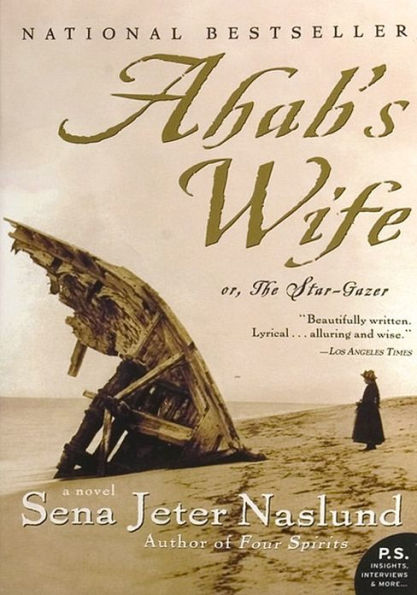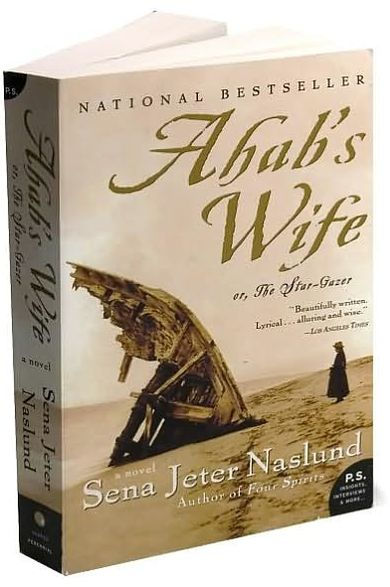Read an Excerpt
Ahab's Wife
Or, The Star-gazer: A Novel
By Sena Naslund HarperCollins Publishers, Inc.
Copyright © 2004 Sena Naslund
All right reserved. ISBN: 0060585854
Captain Ahab was neither my first husband nor my last. Yet, looking up--into the clouds--I conjure him there: his gray-white hair; his gathered brow; and the zaggy mark; I saw it when lying with him by candlelight and, also, taking our bliss on the sunny moor among curly-cup gumweed and lamb's ear. I see a zaggy shadow in the rifting clouds. That mark started like lightning at Ahab's temple and ran not all the way to his heel (as some thought) but ended at Ahab's heart.
That pull of cloud--tapered and blunt at one end and frayed at the other--seems the cottony representation of his ivory leg. But I will not see him all dismembered and scattered in heaven's blue--that would be no kind, reconstructive vision; no, intact, lofty and sailing, though his shape is changeable. Yesterday, when I tilted my face to the sky, I imaged not the full figure but only his cloudy head, a portrait, glancing back at me over his shoulder.
What weather is in Ahab's face?
For me, now, as it ever was in life, at least when he was looking at me alone and had no other person in view, his visage is mild--with a brightness in it, even be it a wild, white, blown-about brightness. Now, as I look at those billowed clouds, I see the Pequod. I half-raise my hand to bid good-bye, as it was that last day from the east-most edge of Nantucket Island, when, with a wave and then a steadfast, longing look, till the sails were only a white dot, and then a blankness of ocean--then--a glitter-- I wished his ship and him Godspeed.
Nantucket! The home where first I found my body, my feet not so much being pulled into this sandy beach as seeking downward, toes better than roots; then, my mind, built not to chart this blue swell of heaving ocean, but the night sky, where the stars themselves, I do believe, heave and float and spin in fiery passions of their own; Nantucket!--home, finally, of my soul, found on a platform eight-by-eight, the wooden widow's walk perched like a pulpit atop my house. These three gears of myself--body, mind, and soul--mesh here on this small island--Nantucket! Then, why, when I look into the mild, day sky, do the clouds scramble, like letters in the alphabet, and spell not Nantucket, but that first home, Kentucky? And those clouds that did bulge with the image of Ahab show me the map of that state, flat across the bottom and all billowed at the top? I did not consult Ahab about my decision to spend my pregnancy in a rough Kentucky cabin with my mother, instead of staying in the gracious home of a captain's wife on Nantucket. But I wrote him, of course, and sent the letter after him on the ship called the Dove, so he could imagine me aright. That time spent with my mother outdoors in the sweet summer and golden Kentucky autumn was augmented by our indoor companionship of sewing baby smocks and cooking and reading again those great works of literature my mother had brought with her to the wilderness, green-bound books I had read as a child or she had read to me.
Sometimes my mother and I stood and looked at our faces together in the oval mirror she had brought with her from the East. Along with her library chest of books, the mirror with its many-stepped molding distinguished our frontier cabin from others. Thus, elegantly framed, my mother and I made a double portrait of ourselves for memory, by looking in the mirror.
When in early December the labor began but tried in vain to progress, my mother went from our cabin, driving the old mare in the black buggy through a six-inch crust of snow, for the doctor. In my travail, I scarcely noticed her leaving. When my mother did not come home and did not come home, and the pains were near unbearable and the chill was creeping across the cabin floor and into my feet as I paced, I grasped the feather bed from my bunk and flung it atop her bed. In desperation, between spasms, I gathered all the gaudy quilts in the house, and then leaving the latchstring out so that I would not have to venture from my nest when she returned, I took to my childbirth bed. There, softness of two mattresses comforted me from beneath and warmth of myriad quilts, a cacophony of colors, warmed me from above, but still I worked my feet and legs and twisted my back.
Despite the heat of my labor, I could feel my nose turning to ice, long and sharp as a church steeple all glazed with frost. Parsnip! I thought of; frozen and funny--a vegetable on my face! I chortled and then prayed, wondering if prayer and laughter gurgled up, sometime, from the same spring. Let nose be parsnip, parsnip be steeple, steeple be nose-whatever that protuberance, it is frozen to the very cartilage. Warm it! Save me, gods and saints! Wild and crazed by pain, my thoughts leaped about in antic dance, circling one picture after another. Nose! Steeple! Parsnip! My desperate, laughing prayer from within that quilted hump below its parsnip was only that I should be delivered and nothing at all for the welfare of the rest of the world. I wanted to wait for my mother's return and I was afraid because I had little idea of how to catch the baby. So even as I prayed, I prayed against myself, that time would not pass nor take me any closer to the port of motherhood. I thought of Ahab, as if his ship were wallowing, going neither forward nor drifting back but immobile in a confused sea.
Copyright © 1999 Sena Jeter Naslund
Continues...
Excerpted from Ahab's Wife by Sena Naslund Copyright © 2004 by Sena Naslund. Excerpted by permission.
All rights reserved. No part of this excerpt may be reproduced or reprinted without permission in writing from the publisher.
Excerpts are provided by Dial-A-Book Inc. solely for the personal use of visitors to this web site.









